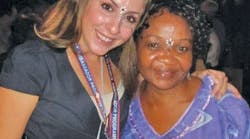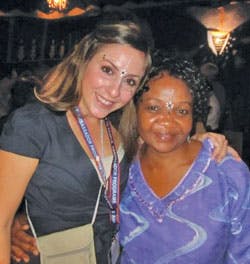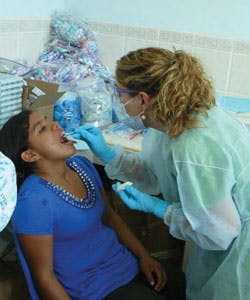by CHRISTINE NATHE, RDH, MS
This month's spotlight focuses on a dental hygienist who recently received the New Mexico Future Leader Award, Professor VickiWhy did you go into dental hygiene?
I've always been interested in working in a health-care field. I thought I wanted to go into optometry, so I began my undergraduate career as a biology major. As I went through school, I was inspired by my aunt, who is a dental hygienist. She is one of the most positive people with one of the greatest personalities that I know. I looked into the prerequisite requirements for dental hygiene and learned that I'd already completed most of them. So I changed directions and applied to the dental hygiene program at UNM. I'm thankful for my decision. This career has been amazing to me, with endless opportunities in education, clinical, research, and being an advocate for the profession. Now I can't see myself doing anything else.
How did you get into dental public health? Did you need additional education?During my work toward an M.S. in dental hygiene, my first experience in public health was at a school-based health program at a local middle school. The program at the time was fairly new, so in addition to seeing patients, I did what I could to help improve the program. After receiving my M.S. in dental hygiene, I worked at a pediatric clinic in an underserved part of the city where patients were low income and primarily Spanish-speaking. I gained experience working with patients with developmental disabilities in another clinic we operate. I quickly learned the vast differences of the working environment in public health compared to a private practice setting. I enjoy how the work I do in public health is very patient-centered as opposed to profit-focused. The patients are very much in need and thankful for the services and education they receive. I also feel that I have more autonomy as a health-care provider in public health. I can schedule and treat patients the way I feel benefits them the most. I feel an M.S. in dental hygiene or public health prepared me for that working environment. Higher education teaches one how to think and problem solve, which are good skills to have in public health.
What are your current positions?
I teach a variety of courses in the dental hygiene program at the University of New Mexico. Clinically, I work in a UNM public health clinic one to two days a week. The experience is rewarding. I feel like I learn more every day.
Can you discuss any particularly interesting experiences you've had in your dental public health positions?
Yes, one particular experience comes to mind where I feel like I had a big impact on a patient. When working at one of the pediatric public health clinics, I treated a sweet young Vietnamese girl. At her first and every subsequent appointment she arrived with her make-up carefully applied, her hair fixed meticulously, and wearing a well-planned outfit. She was brought in by her grandmother who didn't speak any English. She was 14 years old, and this had been her first time to be seen by an oral health-care provider. When I looked into her mouth, she presented with severe gingival hyperplasia extending to the incisal third of her teeth. She had heavy, tenacious subgingival calculus with extremely inflamed soft tissue. I was surprised to see a young girl that took such good care of her appearance present with this extent of extreme oral infection. We worked together through education and multiple appointments. Within four weeks, her oral health drastically improved. She took every recommendation to heart, from her brushing and flossing technique to oral rinse suggestions. I could see how much she appreciated the transition in her mouth. It was rewarding to make such a difference to this young girl. Together, we were able to alleviate her pain and increase her self-confidence, and I trust that she will carry her oral health education with her for the rest of her life.
What type of advice would you give to a practicing hygienist who is thinking of doing something different?
Public health is unique and requires innovative thinking and problem-solving to reach out to the community. I believe that a hygienist who works in public health has many opportunities for creative thinking and to make a positive difference in the needs of his or her community.
Do you have any additional experiences to share?
I had the opportunity to travel to South Africa with other dental hygiene educators in October 2009. The trip was organized by People to People in collaboration with the ADHA. The experience taught me how oral health care is practiced in a country with a very different model for the education and scope of practice for health-care providers. This was also the first time I had seen a population with such abundant health-care needs.
We provided oral health screenings in a community of very low-income people. Many of the patients walked several miles to have a health-care provider look at their mouths. This was very touching to me and motivated me to do more. I wanted to give others a similar opportunity to see, firsthand, the needs outside our country. From this experience, we started an international health program to take UNM dental hygiene students and community dental hygienists to rural areas outside of Granada, Nicaragua, to provide oral health care. In 2011, I organized 36 health-care providers and volunteers, and we treated 243 patients who otherwise would not have received care. For our second medical mission, we've opened this opportunity to the entire University of New Mexico community. In 2013, in addition to traveling with dental hygiene students, we will be taking students from nursing, physical therapy, and occupational therapy, as well as medical residents, to widen our scope of practice and provide interdisciplinary services. RDH
CHRISTINE NATHE, RDH, MS, is a professor and graduate program director at the University of New Mexico, Division of Dental Hygiene, in Albuquerque, N.M. She is also the author of "Dental Public Health Research" (www.pearsonhighered.com/educator), which is in its third edition with Pearson. She can be reached at [email protected] or (505) 272-8147
Consider reading: The U.S. isn't doing enough to prevent tooth decay, says Pew report
http://www.dentistryiq.com/articles/2013/01/the-us-isnt-doing-enough-to-prevent-tooth-decay-says-pew-report.html
Consider reading: Integration Of Oral Health Into Health-Care Systems
http://www.rdhmag.com/articles/print/volume-32/volume-12/columns/integration-of-oral-health-into-health-care-systems.html
Consider reading: Pediatrics and dental public health
http://www.rdhmag.com/articles/print/volume-32/issue-11/columns/value-are-the-cornerstone.html
Past RDH Issues








